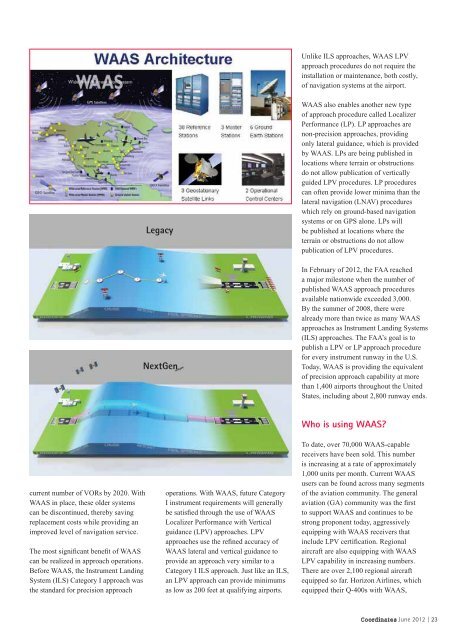Download - Coordinates
Download - Coordinates
Download - Coordinates
Create successful ePaper yourself
Turn your PDF publications into a flip-book with our unique Google optimized e-Paper software.
current number of VORs by 2020. With<br />
WAAS in place, these older systems<br />
can be discontinued, thereby saving<br />
replacement costs while providing an<br />
improved level of navigation service.<br />
The most signi cant bene t of WAAS<br />
can be realized in approach operations.<br />
Before WAAS, the Instrument Landing<br />
System (ILS) Category I approach was<br />
the standard for precision approach<br />
Legacy<br />
NextGen<br />
operations. With WAAS, future Category<br />
I instrument requirements will generally<br />
be satis ed through the use of WAAS<br />
Localizer Performance with Vertical<br />
guidance (LPV) approaches. LPV<br />
approaches use the re ned accuracy of<br />
WAAS lateral and vertical guidance to<br />
provide an approach very similar to a<br />
Category I ILS approach. Just like an ILS,<br />
an LPV approach can provide minimums<br />
as low as 200 feet at qualifying airports.<br />
Unlike ILS approaches, WAAS LPV<br />
approach procedures do not require the<br />
installation or maintenance, both costly,<br />
of navigation systems at the airport.<br />
WAAS also enables another new type<br />
of approach procedure called Localizer<br />
Performance (LP). LP approaches are<br />
non-precision approaches, providing<br />
only lateral guidance, which is provided<br />
by WAAS. LPs are being published in<br />
locations where terrain or obstructions<br />
do not allow publication of vertically<br />
guided LPV procedures. LP procedures<br />
can often provide lower minima than the<br />
lateral navigation (LNAV) procedures<br />
which rely on ground-based navigation<br />
systems or on GPS alone. LPs will<br />
be published at locations where the<br />
terrain or obstructions do not allow<br />
publication of LPV procedures.<br />
In February of 2012, the FAA reached<br />
a major milestone when the number of<br />
published WAAS approach procedures<br />
available nationwide exceeded 3,000.<br />
By the summer of 2008, there were<br />
already more than twice as many WAAS<br />
approaches as Instrument Landing Systems<br />
(ILS) approaches. The FAA’s goal is to<br />
publish a LPV or LP approach procedure<br />
for every instrument runway in the U.S.<br />
Today, WAAS is providing the equivalent<br />
of precision approach capability at more<br />
than 1,400 airports throughout the United<br />
States, including about 2,800 runway ends.<br />
Who is using WAAS?<br />
To date, over 70,000 WAAS-capable<br />
receivers have been sold. This number<br />
is increasing at a rate of approximately<br />
1,000 units per month. Current WAAS<br />
users can be found across many segments<br />
of the aviation community. The general<br />
aviation (GA) community was the rst<br />
to support WAAS and continues to be<br />
strong proponent today, aggressively<br />
equipping with WAAS receivers that<br />
include LPV certi cation. Regional<br />
aircraft are also equipping with WAAS<br />
LPV capability in increasing numbers.<br />
There are over 2,100 regional aircraft<br />
equipped so far. Horizon Airlines, which<br />
equipped their Q-400s with WAAS,<br />
<strong>Coordinates</strong> June 2012 | 23
















